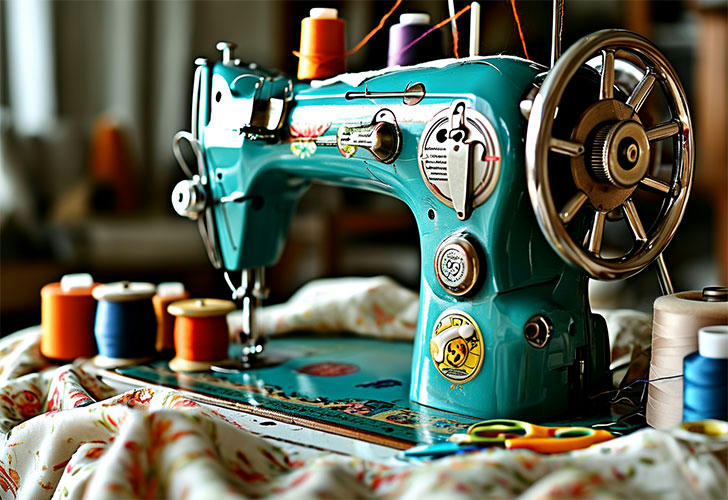Common Home Sewing Machine Problems and How to Troubleshoot Them
Sewing machines are complex devices with many moving parts, and problems can arise from simple wear and tear or improper setup. Instead of immediately taking your machine to a professional, many issues can be resolved at home with a bit of know-how. This guide covers a range of common issues—from skipping stitches and thread jams to uneven tension and machine jamming—and offers practical solutions to help you troubleshoot and maintain your machine.

1. Common Sewing Machine Problems
Understanding what might be going wrong is the first step in fixing it. Below are several common issues you might encounter:
1.1 Skipping Stitches
Skipping stitches are a frequent issue that can result in uneven seams or gaps in your stitching. This problem is often caused by a dull needle, improper needle size, or incorrect tension settings.
1.2 Thread Jams
Thread jams occur when the machine’s thread gets tangled or caught in the feed dogs or bobbin case. This can be due to incorrect threading or a buildup of lint and debris.
1.3 Uneven Stitch Tension
If your stitches are too tight or too loose, the tension may be set incorrectly, or the bobbin might be wound improperly. Uneven tension can lead to puckering or looping on the fabric.
1.4 Machine Jamming
A jammed machine can halt your work entirely. Causes include misaligned parts, excessive fabric bunching, or foreign objects caught in the mechanism.
1.5 Noisy Operation
While some noise is normal, an excessively loud machine might indicate a need for cleaning, lubrication, or repair of worn parts.
2. Troubleshooting and Maintenance Tips
2.1 Regular Cleaning and Oiling
Keeping your sewing machine clean is essential. Dust, lint, and fabric fibers can accumulate in the bobbin area and feed dogs, leading to jams and skipped stitches.
Clean the Machine: Use a soft brush or a dedicated lint remover to clean the bobbin case, feed dogs, and other accessible parts.
Lubricate Regularly: Follow your user manual's guidelines to oil moving parts, ensuring smooth operation and preventing excessive noise.
2.2 Needle Maintenance
A dull or bent needle can cause a host of issues, including skipped stitches and fabric snags.
Change the Needle Frequently: Replace your needle every 8-10 hours of sewing, or sooner if you notice any damage.
Use the Correct Needle: Ensure you’re using the right needle type and size for your fabric and project. Consult your machine’s manual for recommendations.
2.3 Checking Threading and Tension
Incorrect threading is a common culprit for many sewing problems.
Re-thread the Machine: If you experience jams or skipped stitches, remove and re-thread the machine carefully, following the manufacturer’s instructions.
Adjust Tension: Experiment with tension settings on both the upper thread and bobbin. A test stitch on a scrap piece of fabric can help you find the perfect balance.
2.4 Bobbin Care
The bobbin plays a critical role in stitch formation.
Properly Wind the Bobbin: Ensure that the bobbin is evenly wound and inserted correctly. An uneven bobbin can cause inconsistent stitching.
Clean the Bobbin Case: Remove any accumulated lint or dust from the bobbin case to prevent jams.
2.5 Troubleshooting Specific Issues
Skipping Stitches:
- Replace the needle.
- Adjust the tension settings.
- Clean the feed dogs and bobbin area.
Thread Jams:
- Re-thread the machine.
- Remove any tangled thread.
- Clean out lint from the bobbin case.
Uneven Tension:
- Check both the upper and bobbin tension settings.
- Rewind the bobbin evenly.
- Consult your manual for recommended settings based on the fabric type.
Machine Jamming:
- Turn off and unplug the machine.
- Carefully remove any stuck fabric or debris.
- Check for misaligned parts and consult your user manual if the issue persists.
Noisy Operation:
- Clean and oil all moving parts.
- Replace worn or damaged components.
- Ensure the machine is on a stable, flat surface during use.
Final Thoughts
Sewing is an art and a craft that should be enjoyed without the frustration of technical issues. With the right tools, regular maintenance, and a little bit of troubleshooting know-how, most common sewing machine problems can be easily resolved at home. This not only saves you time and money but also keeps your creative momentum going.
So next time you encounter a snag or a jam, remember these tips and products to get back to doing what you love—creating beautiful, handmade items one stitch at a time.
